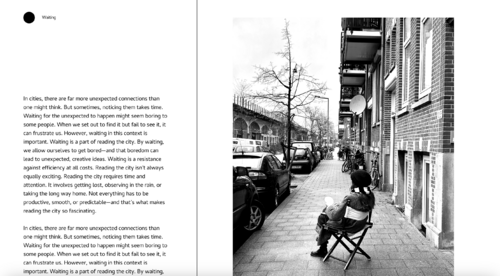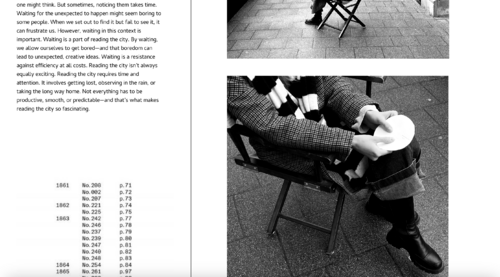User:Mania/Assesment: Difference between revisions
| Line 42: | Line 42: | ||
by working on a: | by working on a: | ||
'''1 . Graphical | '''1 . Graphical scores to energize exploration in physical space''' | ||
[[File:Public moment.jpg|thumb|public moment|536x536px]] | [[File:Public moment.jpg|thumb|public moment|536x536px]] | ||
Scores constitute a system of symbols where elements like time, space, rhythm, and their combinations are presented graphically, visualising a process over time and influencing it. | Scores constitute a system of symbols where elements like time, space, rhythm, and their combinations are presented graphically, visualising a process over time and influencing it. | ||
Revision as of 16:34, 17 December 2024
Project proposal
Relation to previous practice
Fragments Magazine will build upon the experience gained in previous semesters. Starting with the research into neighborhoods as learning environments, which I began in the second semester and drawing heavily from the last Special Issue. Fragments Magazine continues the exploration of the theme undertaken during the Scripts to Read the City project, where I tried to create a series of scripts that encourage spontaneous behavior and exploration of space. The result of the work was a device for reading the city and a guide containing scripts that encourage the discovery of opportunities we might encounter.
Additionally, as part of the project we organised a series of workshops in which participants wrote their own scripts, and then we walked around the city according to a script written by someone else.
For the graduation project I utilize the exploration of the relationship between scripted and spontaneous behaviour, the tension between chance and control, and how the simple tool or a script can enhance unpredictability, stimulate imagination and encourage us to observe space with curiosity.
Treating this as a foundation, I want to experiment more with printed matter, playing with the physicality of paper, to understand how a magazine can shape the way we engage with our surroundings. This project studies how even the simplest tools, which impose certain limitations, can open us to unexpected opportunities and seeing our surroundings in a new way.
What do you want to make?
- Fragments is a magazine that is created for reading our cities.
- I seek ways to open to different experiences, searching for unpredictability and surprises in the city, exciting connections, and interactions with others. And this is what the act of making this magazine public and publishing it outdoors call for.
- By actively existing in public space, it becomes a tool for reading the city i(initiating exploration of space), knowing that this act is an unfinished process. The image of the city is ever changing, its never complete.
Fragments is a way to support performative interactions with space Fragments is an attempt to find diffrent ways to navigate our cities Fragments is an invitation to looking with curious eyes Fragments is a search for unpredictability and surprises in the city Fragments is a place for interactions with others Fragments is published intermittently and meant to be read outside
How do you plan to make it?
Working with limitations; The first issue dedicated for:
PEOPLE who always carry a notebook
TO SEE the choices in how we move
IN open spaces
by working on a:
1 . Graphical scores to energize exploration in physical space
Scores constitute a system of symbols where elements like time, space, rhythm, and their combinations are presented graphically, visualising a process over time and influencing it.
I’m curious about translating what film works with into a system for exploring physical space. Film deals with: frames scripts continuity speed time rhythm...
The most important function of these systems is that they open possibilities without determining what exactly will emerge. Scores allow for the process to constantly evolve.
a) Framing - visualizing movement in a graphical form
There is a difference between graphical representation and the action that results from it. But one informs the other.
A zoetrope moves individual frames, animating them into smooth motion. But when I look at it as a flat image, it becomes a graphic representation of that movement over time. It reminds me of musical notation. What if I were to record movement using symbols, similar to a musical staff? Instead of a composition, I could record a walk…
The zoetrope, by animating frames arranged in a circle, plays with continuity and repetition. Similarly, I could write notes on a staff that loops into a circle, suggesting that this segment should be played repeatedly, over and over. By playing with this looping, we could create a notation for a walking choreography where you continually turn only to the right, or only take narrow streets. Frames, continuity, repetition.
Using script for randomised set of directions. So the action is powered by the computer but what happens depend on the user interpretation.
So the notation is just energizing / initatiating the process happening in the physical space.
b) Playing with elements like speed, time, sequence
walk with a chair
Between object and event
How I will publish it?
- Between object and event
- Workshops - I’m organising a workshop in De Boog
- Playing with paper properites .... kite
- Website - documenting things happening around, moments of coming together and activation in space
Why do you want to make it?
Growing tendency in urban environments where experiences become increasingly seamless. We have services that deliver groceries to our doors, dating apps, and smart solutions that provide us with comfort, but they also create a frictionless environment.
René Boer’s concept of the “Smooth City” ties into this idea. He argues that while everyone deserves a safe and clean environment, such conditions of a smoothness everywhere gradually eliminate opportunities for serendipity, potential, encounters, and all those unexpected events that cannot be planned in advance.
This raises an important question: what kind of cities do we really want? Do we prefer a predictable, frictionless environment, or do we want to embrace random chances? Personally, I long for a city where I can be myself, where I enjoy conversations with strangers, where I discover new paths, where not everything is reduced to the same ideal, polished appearance—a city created by people and therefore full of potential.
With this work I want to design for situations, for friction… I seek ways to open to different experiences, searching for unpredictability and surprises in the city, exciting connections, and interactions with others in shared spaces. Working with system very much open for interpretation it just energize stepping outside, observing and moving through spaces with renewed intrest.
Thesis outline
Through the following chapters, I delve into the tools and sytsems to energize exploration in physical space, the methods that encourage spontaneous encounters inspired by the Situationists, and the importance of creating those situations. Drawing insights from documentaries and early cinema I aim to uncover ways of engaging with surroundings.
Chapter 1
What does it mean to read the city? - Part 1
Tools for reading the city - Part 2
- The Production of Space, Henri Lefebvre
- Smooth City, René Boer
- Creative Processes in the Human Environment
Chapter 2
Methods for spontaneous encounters - Situationists approach and the art of chance
- The term "society of the spectacle”, introduced by French theorist Guy Debord in his book The Society of the Spectacle, describes a society influenced and dominated by images, advertising, and media, where appearances are more important than authentic experience. Following this thought I would like to dive into "Report on the Construction of Situations" by Guy Debord (1957). In this manifesto, Debord explains the concept of "constructed situations" encouraging interventions in urban spaces that provoke new ways of seeing and interacting with the city.
- This chapter is a space for critical reflection on how I can activate the magazine in public spaces.
Chapter 3
Scripts or unintentional adventures? - What documentaries taught me?
- In this context, the book Why I Make Documentaries by director Soda Kazuhiro is especially important to me. In it, he discusses observational filmmaking, speaking about rejecting the idea of preparing a script before shooting and instead creating a story based on discoveries that happen during the process. He also talks about the unexpected discoveries, encounters, and unintentional adventures that the observational filmmaking approach brings. I agree with not strictly adhering to a script, as it’s so easy to cut out even the most interesting scenes simply because they don’t fit a narrowly defined topic. On the other hand, I believe that a script that remains open to interpretation can actually enhance imagination and open up new ways of exploring public space. I believe that scripts and unpredictable encounters can complement each other, and I’m curious how I could explore this further.
- There was this film that I saw during the French film festival - where two characters decided to walk always in a straight line —- so they had to walk on top of the car cause it happen to be on the way.
Chapter 4
Cutting, fragmenting, rearanging - as a way of rewriting our spaces
- Dziga Vertov – Man with a Movie Camera (1929) - This documentary film captures a day in the life of a Soviet city through the eyes of a "movie camera man.” There is no one plot, the film maker is experimenting with montage techniques. Vertov’s approach presents the city as a dynamic, interconnected system.
- Drawing from these examples I will reflect on my practice, which incorporates image-making. I still record and photograph a lot, but then I use this footage to translate it into a collage. fragmenting and rearranging as reimaging. A lot of this happens in my notebook
What is your time table?
BLOCK 1
September, October, November
Content
- Participating in Zine festivals, leading workshop in Groningen
- Experiments with camera obscura, paper frames, photographs and collages
- Public moment
- Finalizing project proposal and research outline
- Coloqium - testing workshop format 1
- Experiment with the formats of the magazine to exist outside
- Prepare the schedule
- Research into existing magazines before I start designing
- The question what I focus on (is it image heavy, repository of tool, do I include cultural context in a written form?)
BLOCK 2
December, January, February
Content
- Assesment
- workshop 2 - De Boog
- workshop 3
Design draft
- idea for possible formats to actively exist outdoors
- practice practice practice web (template tool to print?)
BLOCK 3March, April, May
Design
- Overview of the content (break everything to see what comes page by page )
- How to print cost-effectively and how to get the most out of my format
- Material
Production
- printing
- binding
- fixing
FINAL MONTHJune
Distribution
- Activation in public space
- Documentation
- Celebration
Who can help you and how?
Manetta - with concept and methods and web to print
Joseph - with questions regarding website
Steve - with guidence and valuable references
- questions about working with archival material
References:
Johanathan Crary, Techniques of the Observer
Lorraine Daston and Peter Galison Objectivity, MIT, (2007)
Georges Perec, Species of Spaces and Other Pieces
Lawrence Halprin, The RSVP Cycles. Creative processes in the human environment (1969)
Guy Debord, Report on the Construction of Situations(1957)
The Situationist International (SI) - Situationist maps, like The Naked City (1957), fragment Paris into emotional zones, challenging the conventional ways cities are navigated and understood.
Soda Kazhiro, Why I Make Documentaries, on Observational Filmmaking
Kevin Lynch, The Image of the City
Italo Calvino, Invisible Cities
Rebecca Solnit, Infinite City: A San Francisco Atlas (2010)
Jane Jacobs , The Death and Life of Great American Cities (1961) - Jacobs emphasized the importance of "eyes on the street" and mixed-use urban areas, critiquing large-scale modernist urban planning in favor of organic, community-oriented design.
Dziga Vertov – Man with a Movie Camera (1929)


















